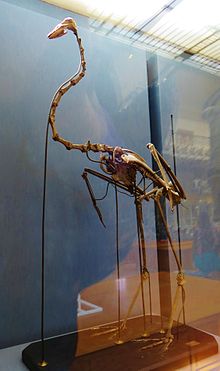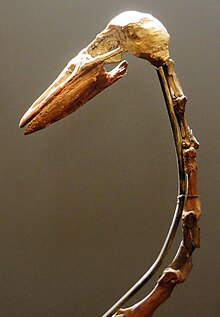Palaelodus
| Palaelodus Temporal range: Possible Pleistocene records.
| |
|---|---|

| |
| Palaelodus ambiguus skeleton, Muséum national d'histoire naturelle , Paris
| |
| Scientific classification | |
| Domain: | Eukaryota |
| Kingdom: | Animalia |
| Phylum: | Chordata |
| Class: | Aves |
| Order: | Phoenicopteriformes |
| Family: | †Palaelodidae |
| Genus: | †Palaelodus Milne-Edwards, 1863 |
| Species | |
| |
Palaelodus is an extinct genus of
History and naming

The genus Palaelodus was first described by French scientist
The name Palaelodus derives from the Ancient Greek "palaios" for "ancient" and "elodus" which means "inhabitant of marshes".[6]
Species
- P. ambiguus
- Known from thousands of bones collected from Late Oligocene to Middle Miocene strata of
- P. pledgei
- A species that was described from a proximal right
- P. wilsoni
- A species described from several leg bones collected from the Etadunna Formation of Lake Palankarinna and named in the same 1998 paper as P. pledgei. Like the other Australian species, P. wilsoni lived from the Oligocene to Miocene (c. 26-24 mya). Several specimens from different localities are referred to this species in addition to the type material, including bones from the Namba Formation. It is the larger of the Australian species and approximately the size of the European P. ambiguus and P. crassipes. The name of this species is derived from the Wilson family that allowed fossil collectors access to their property.[9] A single specimen from the Pleistocene Kutjitara Formation near Cooper Creek (roughly 0.2 mya) was also assigned to this species, however more recent research has left it doubtful whether or not the Pleistocene remains belong to P. wilsoni. Subsequently, they may have been those of a different species of Palaelodus or, given the enormous gap in the fossil record, a different genus all together.[3]
- P. aotearoa
- A species based on two stout distal tibiatarsi and a tentatively referred sternal fragment from the Bannockburn Formation of New Zealand's South Island. P. aotearoa was a medium sized palaelodid and substantially larger than the contemporary P. pledgei, the species that occurred in Australia around the same time. It was slightly smaller than P. wilsoni and in the same general size range as P. ambiguus. The specific epithet is a Māori language name for New Zealand.[3]
- P. kurochkini
- The first and currently only known species of Palaelodus from Asia, P. kurochkini was described on the basis of a single partial tibiotarsus found at the terminal Middle Miocene (MNU 7) Ooshin Formation in Mongolia. Several fossils are tentatively assigned to this species, including fragments of the carpometacarpus, a phalanx and a tarsometatarsus. P. kurochkini is a medium-sized member of its family, with the holotype being about the size of a modern American flamingo. Due to some traits differentiating it from both Palaelodus and Megapaloelodus, it may actually represent a distinct genus. Until more material is discovered however it's provisionally included in Palaelodus. It was named in honor of the late Prof. Evgeny Kurochkin.[10]

Disputed species
- P. gracilipes
- A species named alongside P. ambiguus and P. crassipes from the Aquitanian of Saint-Gérand-le-Puy and also found in Nördlinger Ries (MN 6). According to Mlíkovský, this species only represents smaller individuals of the type species, but other researchers argue that declaring the two species synonyms, while not out of the question, would be premature without an extensive look into the available material.[3]
- P. crassipes
- A species named alongside P. ambiguus and P. gracilipes from the Aquitanian of Saint-Gérand-le-Puy and also found in Nördlinger Ries (MN 6) and the Steinheimer Basin (MN 7). According to Mlíkovský, this species only represents larger individuals of the type species. Other researchers however argue that declaring the two species synonyms would be premature until the European material is examined in greater detail.[3]
Megapaloelodus goliath was originally described as a species of Palaelodus, but later moved to the American genus Megapaloelodus due to its more robust morphology separating it from the contemporary Palaelodus ambiguus. Still, Mlíkovský suggests that this species should be returned to its original designation.[3] The crane Pliogrus germanicus is now considered to be a type of palaelodid, possibly in the genus Palaelodus.[8]
Description

The
The mandibular ramus is notably deep with an almost straight upper edge and a lower edge that bends and narrows only far behind the
Specimens from the Mainz Basin as well as Saint-Gérand-le-Puy both show that the

The
Although still relatively long, the legs of Palaelodus were not nearly as elongated as those of modern flamingos. In particular, the tarsometatarsus was notably shorter than the humerus while the opposite is true for phoenicopterids. The tarsometatarsus further differs from flamingos in that it is laterally compressed, more similar to what is seen in grebes.[3] The pelvis also differs from flamingos, being more narrower than in the extant waders.[4]
Phylogeny
The
| Mirandornites |
| ||||||||||||||||||
Paleobiology
Locomotion
Due to its unique anatomy and intermediary position within mirandornithes, the exact ecology of Palaelodus is not entirely understood. Cheneval and Escuillié both suggest that Palaelodus may have been a diver using its webbed feet for propulsion,[2] however this hypothesis has been questioned by the works of Mayr as well as Worthy and colleagues, both of whom suggest different alternatives. In Worthy et al. (2010) it is suggested that palaelodids were wading birds, more akin to flamingos,[3] while publications by Mayr suggest a swimming lifestyle.[4][11]
Some of the traits used to infer a diving lifestyle were noted to be also present in flamingos while a pneumatised humerus, as present in Palaelodus, is entirely unknown in divers.[13] Worthy and colleagues point out that, while having laterally compressed tibiotarsi may be a trait shared with diving birds, no bird with such a lifestyle features the same degree of limb elongation as present in Palaelodus. They counter that the compression, as well as other traits of the hindlimbs, could just as well be adaptions to more easily wade through deeper water.[3] Mayr meanwhile specifically points to several traits that according to him support a swimming lifestyle. The compression of the toes is unlike what is seen in any modern wading bird, while the decreased ability to flex the toes suggests the use of the webbed feet as stiff paddles. The distinctly narrower pelvis also points towards a different way of life than that of flamingos.[4]
Feeding
Cheneval and Escuillié proposed that the deep mandible of Palaelodus may have housed an enlarged tongue similar to that of flamingos and that these birds may have shown the first signs of becoming filter feeders. Although not directly disputing the presence of an enlarged tongue, Mayr points out that the bill of Palaelodus lacked the widened rim that holds the keratinous lamellae that allow flamingos to filter water. Subsequently, even if a thick tongue was present, Palaelodus would likely not have been able to filter feed in the same manner as adult flamingos. Instead the bill shows greater similarity to those of juvenile flamingos, which have not yet developed this mechanism. Furthermore, the enlarged fossae on the sides of the mandibular ramus indicate that movement of the head played a greater role in foraging than it does for flamingos, pointing to a more conventional method of feeding. Besides the anatomy of the mandible, the way the spine is formed is another indicator that palaelodids differed in ecology from flamingos. Flamingos feed while standing with their necks lowering at a right angle, likely aided by the kink in the spine prior to the shoulder girdle. As this kink is not nearly as pronounced in Palaelodus, they likely assumed a different position while feeding. This also matches the fact that the bill lacks the typical hooked shape of the flamingo bill.[4]
Fossils of Palaelodus are exclusively known from

Social behavior may have varied between species. Worthy and colleagues argue that the discovery of thousands of bones in France could indicate that the European Palaelodus species may have lived in large flocks like modern flamingos. Species from Australia and New Zealand meanwhile may have been less social based on the fact that only few bones are known across multiple localities. This case is made partially in light of the palaelodid remains from New Zealand, where fossil ducks are found in abundance likely due to flocking behavior, yet the remains of phoenicopteriforms are rare.[3]
Paleoenvironment
The genus is known to have inhabited saline and brackish lakes and was especially abundant in the Oligocene to Miocene sediments of Europe, where between two and four species may have coexisted. However, this great species diversity depends on whether or not M. goliath is found to nest within Palaelodus and whether or not Milne-Edwards species only represent a single taxon. In Neogene Australia Palaelodus species greatly profited from the availability of salt lakes in the Lake Eyre Basin, where the two recognized species shared their habitat with more derived species of flamingos such as Phoenicopterus novaehollandiae. The presence of juvenile specimens at the Australian lake deposits furthermore shows that these birds bred and nested in these localities.[9] In New Zealand P. aotearoa was found in what is now the Bannockburn Formation, the sediments of the 5,600 km2 (2,200 sq mi) paleo-Lake Manuherikia which was fed by a river delta. The avifauna of this lake was dominated by anseriforms, but also featured other birds associated with bodies of water like wading birs, cranes, rails, tubenoses, herons and gulls. Several factors indicate that the environment P. aotearoa was deposited in was heavily affected by wave activity and currents within the lake.[3]
References
- ^ Milne-Edwards, Alphonse (1863). "Mémoire sur la distribution géologique des oiseaux fossiles et description de quelques espèces nouvelles". Annales des Sciences Naturelles (in French). 4 (20): 132–176.
- ^ .
- ^ .
- ^ .
- ^ Cheneval, J.; Escuillié, F. (1992). "New data concerning Palaelodus ambiguus (Aves: Phoenicopteriformes: Palaelodidae): ecological and evolutionary interpretations". In Campbell KE Jr. (ed.). Papers in Avian Paleontology honoring Pierce Brodkorb. Vol. 36. Nat Hist Mus Los Angeles County Science Series. pp. 208–224.
- JSTOR 24315002.
- ^ Alvarenga, H.M.F. (1990). "Flamingos Fósseis da Bacia de Taubaté, Estado de São Paulo, Brasil: Descrição de Nova Espécie". Anais da Academia Brasileira de Ciências. 62 (4): 335–345.
- ^ S2CID 55282934.
- ^ .
- S2CID 84607510.
- ^ S2CID 18198929.
- ISSN 1864-211X. Retrieved 12 August 2009.
- ^ ISSN 0024-4082. Retrieved November 3, 2009.


